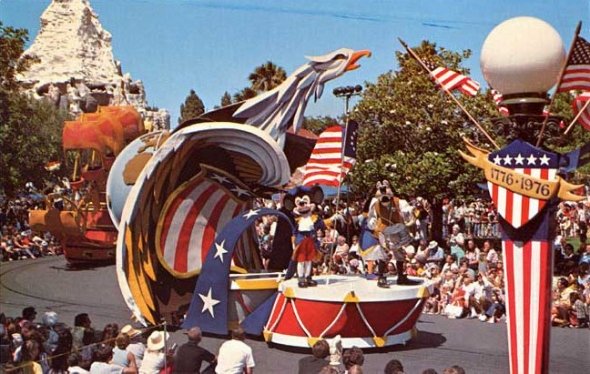
Imagine. It’s 1976. America is celebrating its bicentennial and, across the entire country, celebrations have been ongoing for a year. If you can imagine, the bicentennial had spread unbridled and organic patriotism. Americana was in full swing and – put simply – people were just proud to be Americans.
And there may be no better place to celebrate that than Disneyland, with its brass plaque engraved with Walt’s dedication, calling for the park to be “dedicated to the ideals, the dreams, and the hard facts that have created America.” Disneyland is Americana incarnate; it’s a celebration of pop culture, architecture, and the collective consciousness of the Western world.
In fact, guests stepping into Walt Disney’s park pass beneath a plaque offering a simple idea: “Here you leave today and enter the worlds of yesterday, tomorrow, and fantasy.”
And in the brand new Discovery Bay, you can be in all three at once.
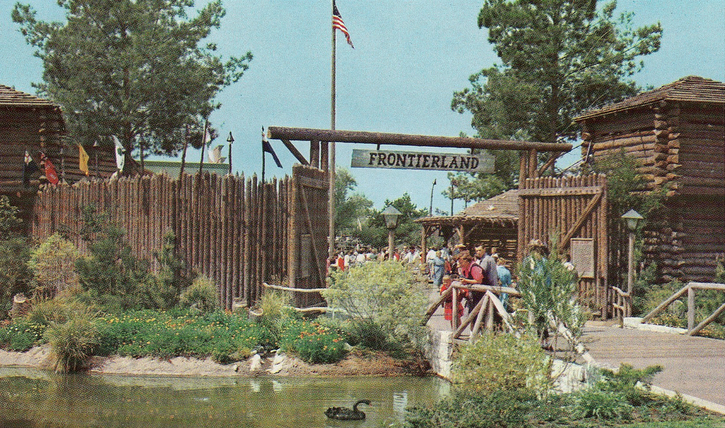
It all begins in the park’s Frontierland – one of the park’s five original lands as overseen by Walt Disney in 1955. Frontierland is meant to be a celebration of the nation’s roots and – more importantly – its growth.
Westward expansion was at the heart of American optimism in the 19th century and the call for “manifest destiny” meant that Americans were destined to expand throughout the continent, claiming new territory and leading lives of fulfillment and promise. The sleepy Western town of Frontierland is somewhat like a living museum of the era, encapsulating the endurance that 1860s explorers must’ve displayed.

But now, on the edge of the quiet mining town is something new. Soaring red peaks have appeared – a deep red, iron-rich mountain range of knobby, almost unbelievable spires. This new, headlining attraction is the one you’ve heard people talking about – Big Thunder Mountain Railroad. It’s a world away from the hokey Mine Train Through Nature’s Wonderland that had been touring through comical wildlife scenes and through desert rocks for two decades.
On board, you’re whipped around tight turns and past all manner of desert creature as your runaway train barrels through precarious tunnels and freshly dug mines. Big Thunder Mountain dips and twists through caverns in a runaway mine train adventure, placing guests face-to-face with bats, stalactites, floods, and cave-ins!
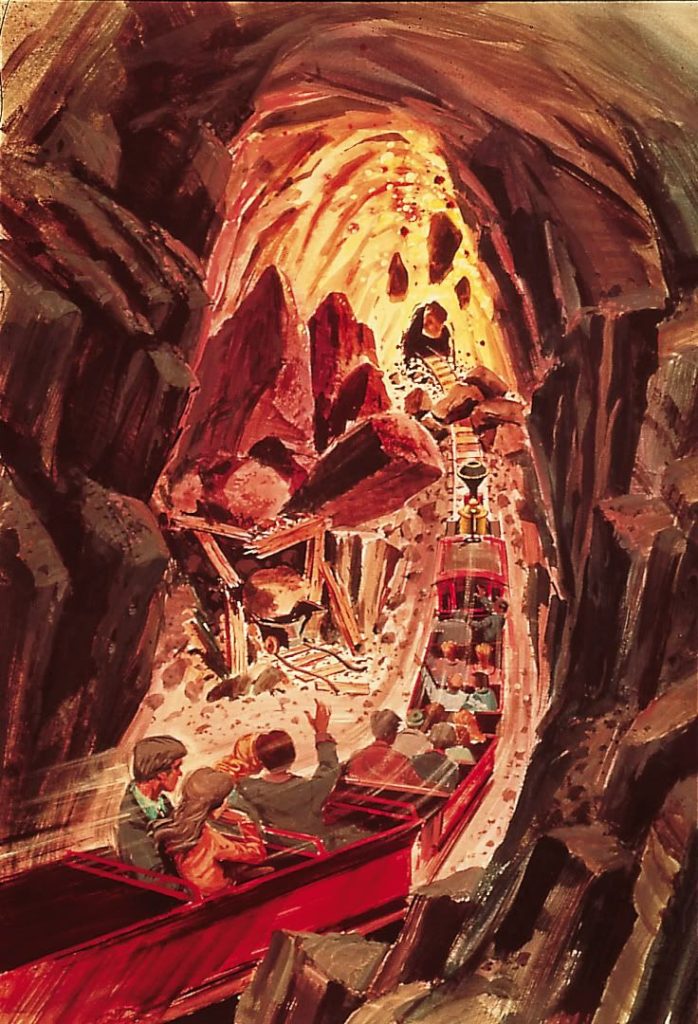
But legend has it that there’s gold deep inside of the mountain.
Big Thunder Mountain is exactly what Disneyland needed. It’s got the magnetic draw of a thrilling roller coaster, but its gentle slopes and vivid scenery makes it perfect for the whole family. Once you’ve unloaded from the coaster, your adventure has only just begun.
Big Thunder Mountain is only the first part of this brave new expansion to Disneyland. It serves as the gateway to a most unusual and picturesque place. With our gold in tow and our adventuring sense piqued, we’ll follow a caravan of explorers before us by packing up our wagons and continuing our drive West, eventually arriving at the coast…
Discovery Bay
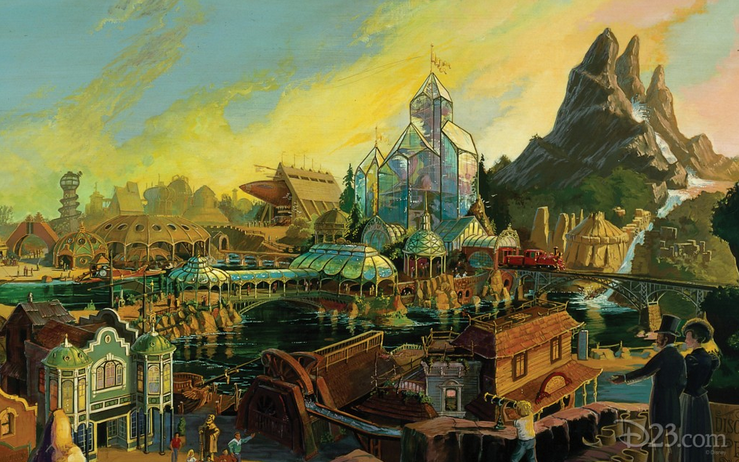
When you cross into Discovery Bay, you’re joining a story that’s been unfolding for decades. This seaside port – constructed along the northeastern edge of the Rivers of America – is meant to resemble the city of San Francisco from roughly 1860 to 1880 – just after the California Gold Rush when the city was called “the Paris of the West.”
But in this reality, the coastal port has been passed through Disney’s signature lens of romanticism and fantasy – in this version of San Francisco, gold has drawn international adventurers, explorers, thinkers, and designers to create an eclectic bronze bay of astounding architecture, cultural melding, and technological marvels that we today might call “steampunk.”
An astounding mix of European literature and American wonder, Discovery Bay contains multiple original, astounding attractions.
The Waterfront
Like so much of Disneyland, Discovery Bay would feed from the Rivers of America. Where once had been remote undeveloped forests north of Tom Sawyer Island, a new rocky coastline would give way to a new kind of forest: dozens of masts, ropes, and sails of ships, all docked in the harbor of a new waterfront. In fact, the park’s Sailing Ship Columbia would be permanently docked here at Explorers Wharf.
Guests could not only climb the gangplank onto the ship to explore its multiple levels, but make their way through the wharf’s mazes of climbing nets, crates, and interactives – a West Coast wharf open for discovery, play, and pretend.
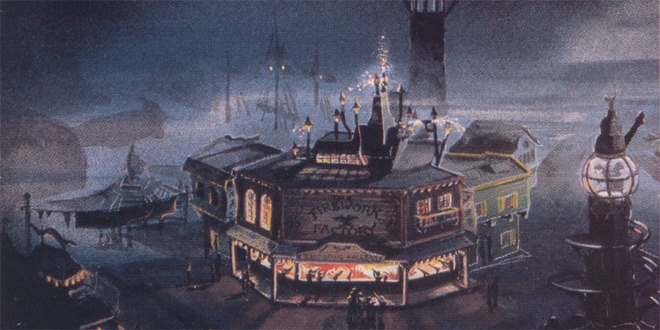
At the water’s edge, guests would find Chinatown, a culinary district of restaurants and shops where Chinese immigrants had developed their own wharf. (You might compare this detailed area to California Adventure’s Pacific Wharf, which is modeled after nearby Monterey’s cultural docks).
In Chinatown, you’ll find the most unusual Fireworks Factory attraction. Early drafts of Discovery Bay call it a shooting gallery along the lines of Frontierland’s (above), but some iterations cast it as an interactive dark ride as riders launch pinwheels, sparklers, and firecrackers along the factory’s assembly line.
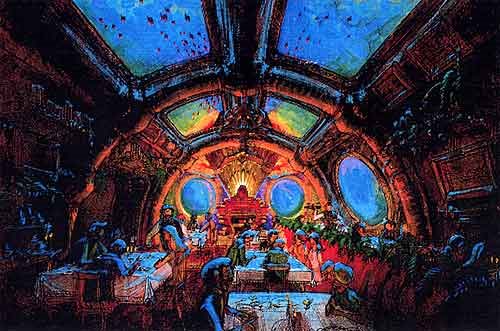
Visibly docked out in the Rivers of America is a 200 foot long recreation of the iconic Nautilus submarine (as designed by Harper Goff for the 1954 film 20,000 Leagues Under the Sea). Ascending down a spiral staircase at the water’s edge, you can enter into the parked Nautilus for a walk-through of the film’s most famous scenes (including a run-in with the menacing squid).
Guests aboard the Nautilus would also find the blueprints for the fantastic power structures that would power Discovery Bay, tying the Verne universe to Disneyland’s new area, and – in some descriptions of the land – a simulator ride (predating the technology’s Star Tours debut) through Nemo’s nautical world called Captain Nemo’s Adventure. The Nautilus would also be home to a luxurious full service restaurant in the submarine’s Grand Salon (above), giving guests the chance to “look out” into the waters of the bay.
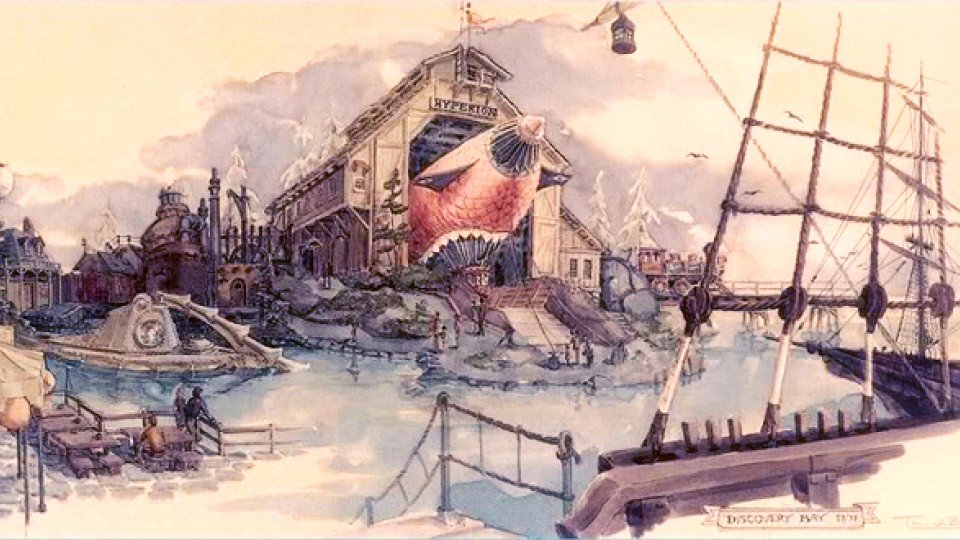
Certainly, though, the land’s main attraction would’ve been located in a hangar just near the water’s edge. The crimson canopy of the Hyperion Airship would serve as the icon of Discovery Bay and its headlining attraction: Voyage to the Top of the World. In this E-Ticket dark ride adventure, guests would climb about their own Airships and head north, following the aurora borealis toward the Arctic.
Descending from the clouds to avoid an incoming storm, guests would float over the Arctic, just over the heads of polar bears before descending into an icy labyrinth. When a herd of migratory whales attack, the Hyperion would burst through an ice wall and find itself in the lost island of Astragard – home of mystical creatures and a forgotten tribe of Vikings concealed from the world by the mists of time. Only an otherworldly winter storm could catch the Hyperion and return it safely to Discovery Bay.

In fact, this anchor attraction would be narrated by Pete Renaday (who had voiced Captain Nemo on Magic Kingdom’s 20,000 Leagues attraction) and would be similarly situated as the land’s epic sci-fi fantasy journey through immensely-scaled scenes and harrowing encounters. But even if the Voyage to the Top of the World would be a new headliner for Disneyland, Discovery Bay had more to offer.
The Streets
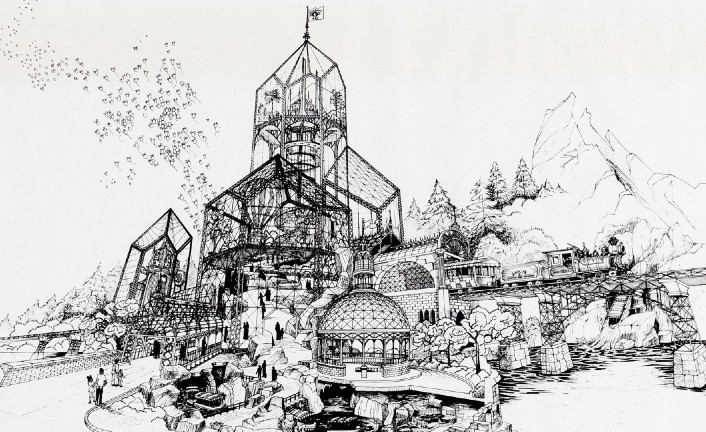
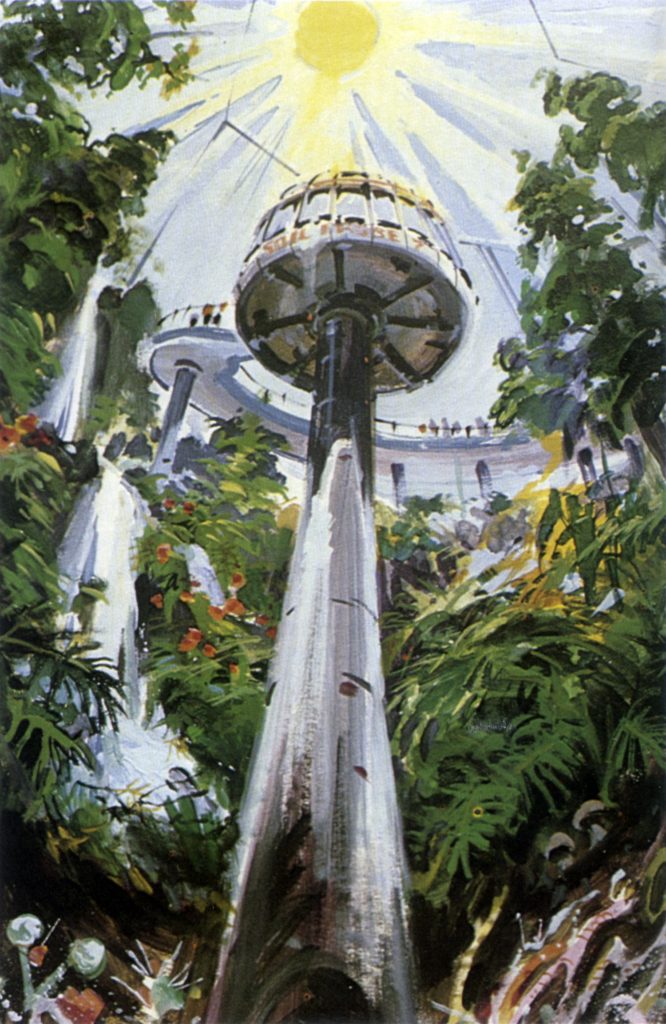
Moving inland from the cultural Waterfront, the interior of Discovery Bay is lavishly decorated as an early Victorian high society port of elaborate dance hall exteriors, plush chaise lounges, crystal chandeliers, and more, all disguising actual merchandise locations selling artisan crafts, scientific supplies and scale model figurines of Disneyland attractions.
Of course, they’d all be reigned over by a great prismatic glass tower set into the base of a distant, craggy mountain peak.
In this Victorian steampunk greenhouse, guests would find a really-for-real Botanical Gardens walkthrough, ascending gradually through the tower around hot air balloons and through recreated habitats to reach the tower’s peak, with views across Discovery Bay, Frontierland, and New Orleans Square.
Nearby, boats would be dispatched from the docks of Discovery Bay. Frankly, this is one of the Discovery Bay attractions we just don’t know much about – the Lost River. By most accounts, this seafaring journey was envisioned as fantastical sci-fi Jungle Cruise for Discovery Bay, with guests’ boats passing through a time portal and emerging in a world of volcanic chasms, primordial forests, and dinosaurs.
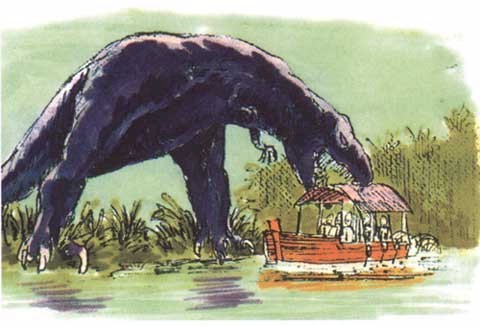
This Time Machine tale may have even planned to reuse the dinosaur Audio-Animatronics developed for Ford’s pavilion at the 1964 – 65 New York World’s Fair (relocated to the Disneyland Railroad at the Fair’s close) as a family journey through the prehistoric past and back again.
The Carnival
But outside of town proper, guests would find a marvelous sub-land: the traveling carnival of the enigmatic and electric Professor Marvel.
Perhaps the attraction Disney fans most would like to have seen was Professor Marvel’s Gallery of Wonders. This one-of-a-kind attraction was featured in a revolving theater (similar to the Carousel of Progress, which had just been vacated to be relocated to Magic Kingdom) and would star an inventor and explorer named Professor Marvel who would introduce his menagerie of unbelievable animals, experiments, and inventions during the musical journey.
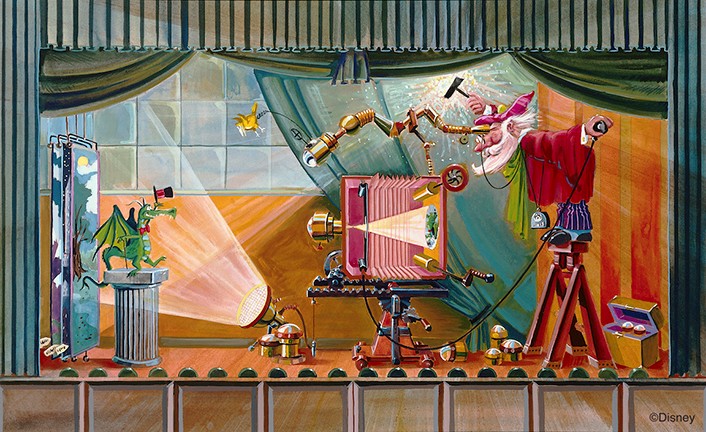
Perhaps his most astounding find was his pet dragon, which faithfully sits on his shoulder as he recounts the magical journeys he’s had.
Just outside of town along a grassy hill would stand Professor Marvel’s Balloon Ascent, a Skyway style attraction with guests suspended below hot air balloons to lift up and over Discovery Bay for flights to the nearby Dumbo’s Circusland (a co-planned expansion of Disneyland’s Fantasyland, later adapted into Magic Kingdom’s Storybook Circus).
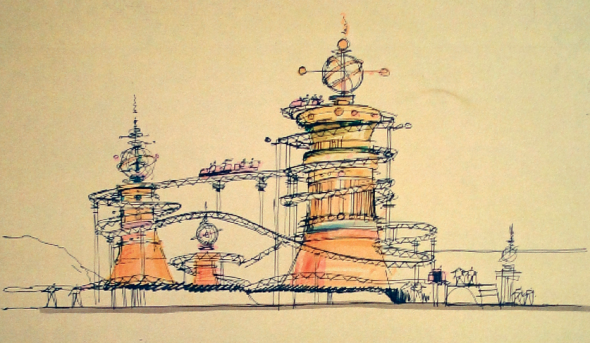
Elsewhere, the Spark Gap coaster would’ve been the land’s signature family thrill ride, wrapped around tremendous gold towers pulsing with Tesla coil electrical sparks. The Spark Gap coaster would appear to be drawn up its spiral lift hill through magnetism before spiraling its way down around and through the otherworldly towers.
Potential
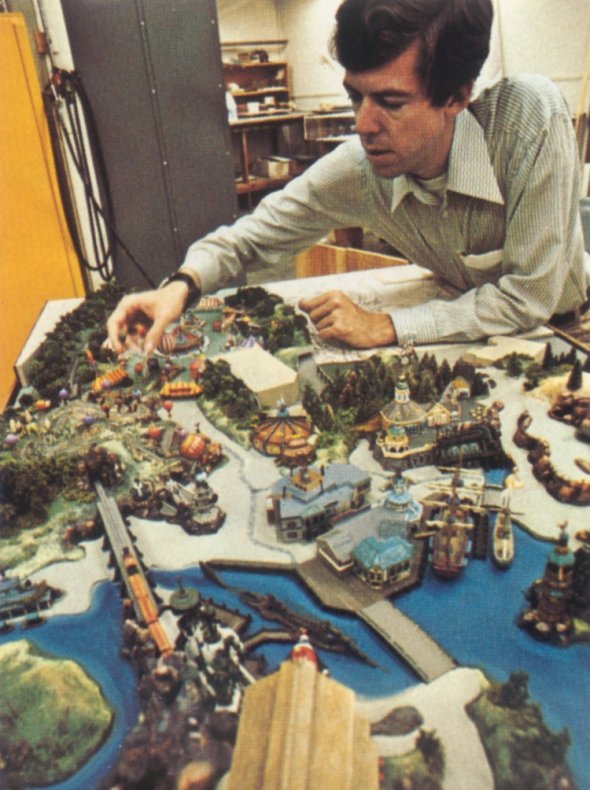
If Discovery Bay had been built, it would’ve been a perfect mix of science fiction, literature, original characters, fantasy, and history. Originally intended to be a mere expansion of Frontierland, Discovery Bay clearly stood as a land of its own. With a narrative born of Western expansion and sharing a common continuity thanks to Big Thunder Mountain, Discovery Bay still seemed like so much more.
And how incredible would’ve it have been if the Rivers of America contained four shores, each representing a different American story: the folk-tale backwoods (Critter Country), New Orleans Square, the Old West (Frontierland) and a retro-futuristic San Francisco (Discovery Bay)? When it was officially announced in 1976, fans were delighted. But Discovery Bay never opened. We’ll find out why on the next page.


